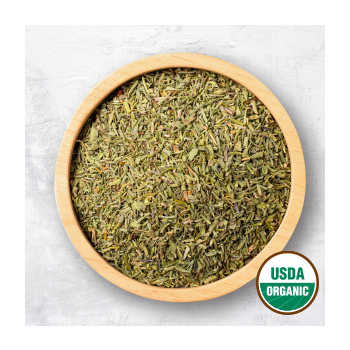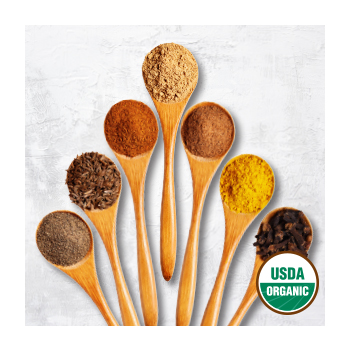


Sign-up for {N}power to get exclusive discounts, newsletters, members-only features, and more!

A dash of cumin, a sprinkle of thyme, a shake of oregano and suddenly the kitchen is filled with mouth-watering scents. Layers of aroma transport you back in time to standing on a stool as a little one to reach the countertops and be the one to add in the secret ingredient—that special blend of herbs and spices that makes food come alive.

When we think about ‘organic,’ we might imagine biodiverse farms buzzing with life, fruits and veggies vibrant and thriving without chemical pesticides or synthetic fertilizers. And yes, this is a critically important piece, but organic standards don’t stop at the growing stage. Processing practices must also meet strict regulations to maintain the integrity of what it means to be organic.1 Important ‘ingredients’ for herbs and spices to be labeled organic include:

Spice up your life! But be wary of conventional dried herbs and spices. When herbs and spices are dried, pesticide residues become concentrated and can exceed federal regulatory allowances. A study testing pesticide levels on commercial herbs and spices found that 10 percent of oregano and 46 percent of thyme samples exceeded regulatory maximum residue levels.2 3 Yikes! To make matters more concerning, conventional spices are notorious for fillers. Golden yellow lead chromate—known to damage nerves and vital organs—has been found as a filler in ground turmeric. Double yikes! If all of this weren’t bad enough, conventional herbs and spices are also commonly treated with the synthetic fumigant ethylene oxide or propylene oxide (PPO). Neither make a good addition to your seasoning—ethylene oxide is a carcinogenic fumigant and PPO is a fuel-additive shown to have damaging effects on DNA synthesis.5 6 Organic herbs and spices are an easy (and important!) choice to keep things spicy and free from toxic additives and pesticides.
Irradiation is common practice for sterilization in conventional food production, especially for herbs and spices. During this process food passes through chambers of ionizing radiation from one of three sources: gamma rays from cobalt-60, x-rays, or electron beams.7 The high-energy beams radiate through the food, killing microorganisms that could make us sick, but also leaving a “trail of chemical transformations” in the food.8 Irradiation has some concerning consequences and is prohibited in organic production because it alters the natural state of the food. Studies have shown that irradiation impacts nutritional quality, reducing the amount of certain vitamins including A, C, B, and E.10 11 In addition to the health risks irradiation poses for workers, such as exposure to radiation, there are also the environmental risks of radioactive waste contaminating land and water systems.
So next time you replenish your spice cabinet, avoid the toxic fumigants, fillers, preservatives, and irradiation and keep it clean with organic!

Ounce for ounce, herbs and spices are some of the most nutrient dense foods we have, and Indian food really exemplifies how to put these flavorful, health-promoting foods to good use. This curry, inspired by Indian butter chicken, is quick and easy to put together.



Sign-up for {N}power to get exclusive discounts, newsletters, members-only features, and more!